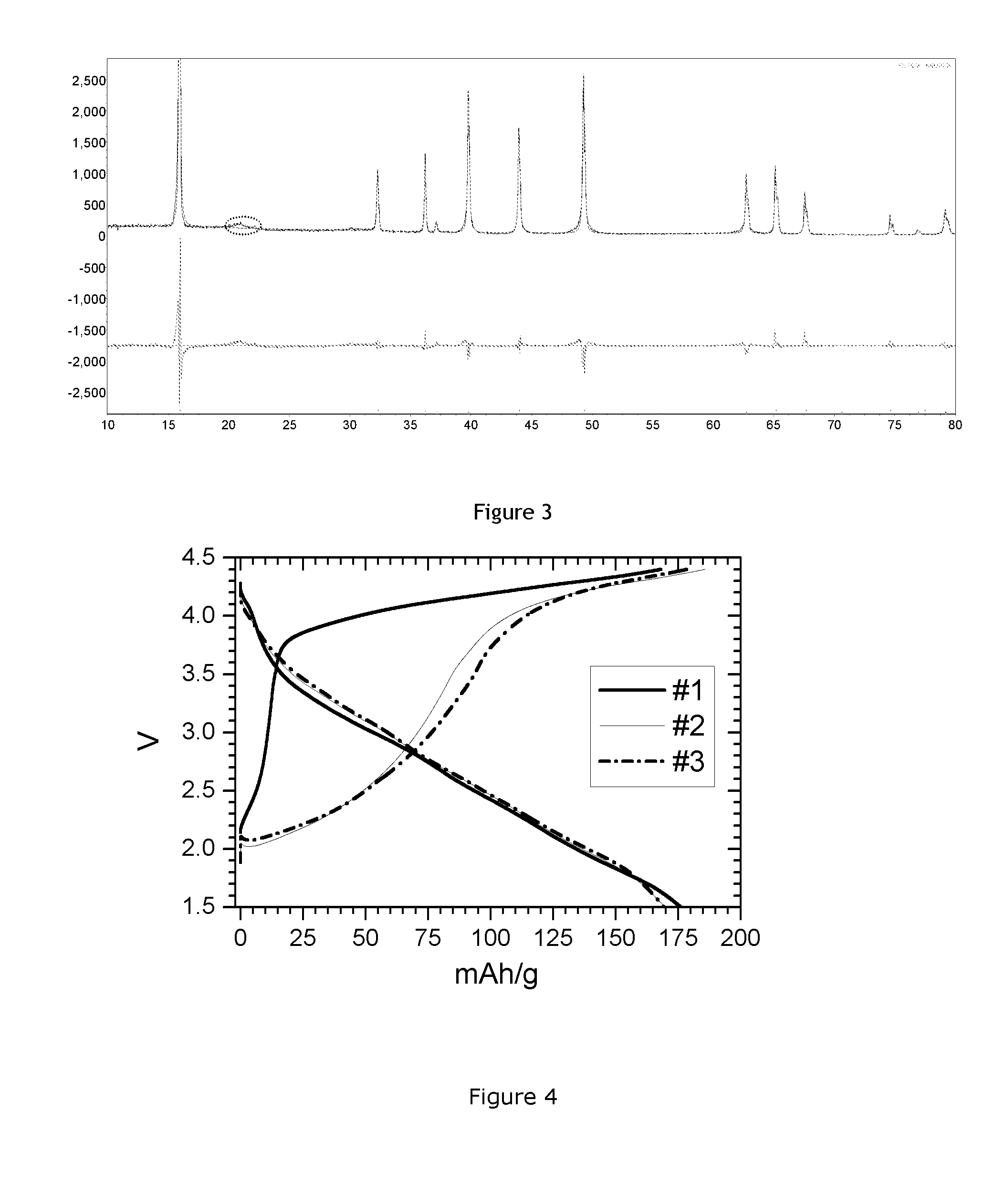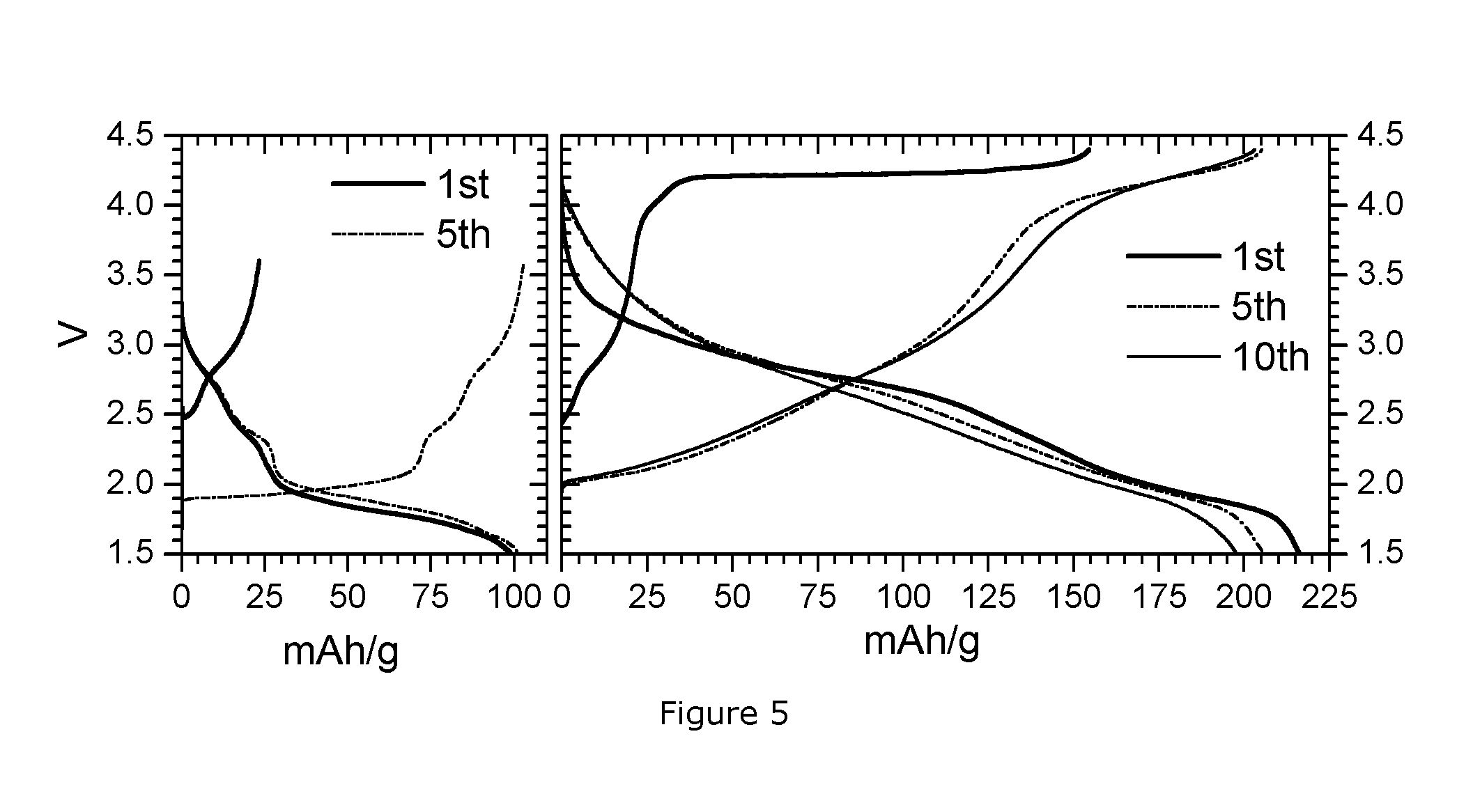Doped Sodium Manganese Oxide Cathode Material for Sodium Ion Batteries
a sodium ion battery and manganese oxide technology, applied in the direction of positive electrodes, cell components, electrochemical generators, etc., can solve the problems of limited practically available recourses to about 13 million tons, insufficient resources for a world full of “green cars” and difficult to produce sufficient lithium precursors in a sustainable way
- Summary
- Abstract
- Description
- Claims
- Application Information
AI Technical Summary
Benefits of technology
Problems solved by technology
Method used
Image
Examples
example 1
Preparation and Electrochemical Testing
[0085]A P2 type Na—Mg—Mn oxide was prepared from Na2CO3, Mn2O3 and basic magnesium carbonate (MgCO3)4Mg(OH)2*5H2O. After mixing reagents the mixture was heated at 900° C. in air followed by quenching to yield Na0.7[Mg1 / 3Mn2 / 3]O2.
[0086]The obtained powder was investigated by XRD powder diffraction (CuKα radiation, wavelength 0.15418 nm). FIG. 1 shows the obtained pattern together with the indexing of diffraction peaks using the hexagonal P2 structure. Basically single phase, high crystalline P2 structure NaxMg1 / 3Mn2 / 3O2 is achieved.
[0087]The obtained powder was tested in a coin cell with sodium metal anode. Electrode active loading was 3.2 mg / cm2. Electrode composition was 8:1:1 (active material:binder (PVDF):carbon). The electrolyte is 1 M NaClO4 in PC (propylene carbonate): DMC (dimethyl carbonate): FEC=49:49:2. The charge discharge voltage range is 1.5-4.4V. The current density is 10 mA / g. FIG. 2 shows the obtained results (1st, 2nd and 3rd c...
example 2
Preparation of Single Phase P2 Nax[LiyMn1-y]O2 with High x
[0088]The intention of this Example is to demonstrate the possibility to increase the Na:M (M=Li+Mn) ratio beyond 0.67 but keep a high tetravalent manganese content. Similar results are expected independently if Mg, or Li or other low-valent dopants are used. Since Li doping is simple, and good results can be achieved without use of mixed precipitated precursors, but by using a simple solid state reaction, results for Nax[LiyMn1-y]O2 are shown.
[0089]A large series of samples with varying Na:M and Li:Mn ratios is prepared. Powders are mixed at stoichiometric ratio in a coffee grinder for 1 minute, and pelletized with each pellet mass around 1.7 g. Samples are heated under air ambient air 750° C. for 12 hours, the product is then cooled down to room temperature, and grinded again in a coffee grinder. Table 1.1 lists the samples, target composition and precursors. The table shows samples as divided into 4 sub-groups A-E. The sub...
example 3
Manganese Valence State and Composition of P2 Phases
[0092]Table 2 shows the results of a phase analysis. The left side of the Table gives the target composition and lists the theoretically expected manganese valence state if only single phase P2 phase would be expected. The right side of the Table shows the composition of the observed P2 phase within a phase mixture. It also gives the corresponding ‘real’ manganese valence state of the P2 phase. The XRD analysis with multiphase Rietveld refinement gave quantitative results for the concentration of the P2 phase and impurity phases. Typically the phase mixture contained mostly P2 phase and impurity phases of Li2MnO3 and / or Na2CO3. The real P2 phase composition is achieved by subtracting the Na, Li and Mn of the impurity phases from the target composition, furthermore assuming a Nax[LiyMn1-y]O2 composition. Group A is excluded because it contained high concentrations of impurity phase. Group F is an example of Nax[MgyM1-y]O2.
[0093]Tabl...
PUM
| Property | Measurement | Unit |
|---|---|---|
| charge voltage | aaaaa | aaaaa |
| charge voltage | aaaaa | aaaaa |
| charge voltage | aaaaa | aaaaa |
Abstract
Description
Claims
Application Information
 Login to View More
Login to View More - R&D
- Intellectual Property
- Life Sciences
- Materials
- Tech Scout
- Unparalleled Data Quality
- Higher Quality Content
- 60% Fewer Hallucinations
Browse by: Latest US Patents, China's latest patents, Technical Efficacy Thesaurus, Application Domain, Technology Topic, Popular Technical Reports.
© 2025 PatSnap. All rights reserved.Legal|Privacy policy|Modern Slavery Act Transparency Statement|Sitemap|About US| Contact US: help@patsnap.com



